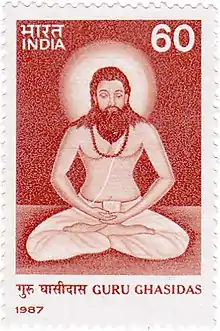Ghasidas
Guru Ghasidas (18 December 1756 – 1850),[1] was guru (spiritual teacher) of the Satnampanth in the early 19th century. It was Guru Ghasidas started preaching in a deep forested part of Chhattisgarh.[2]
Guru Ghasidas | |
|---|---|
 Guru Ghasidas on a 1987 stamp of India | |
| Born | 18 December 1756 |
| Died | 1850 |
| Monuments | Jai Khamb Satnam Gurudwara |
| Nationality | Indian |
| Other names | Satguru Satnam |
| Successor | Guru Balakdas |
| Spouse | Safura Mata |
| Children | Guru Balak Das, Guru Amar Das, Guru Agar Das, Guru Adgadhiya Das, Mata Sahodra |
| Parent(s) | Mahangu Das, Mata Amarautin |
Ghasidas was born on 18 December 1756[3] at the Giroudpuri village of Nagpur (present-day village of Giraudpuri at Baloda Bazar in Chhattisgarh) in a Satnami Chamar family[4][5][6][7] Guru Ghasidas was the son of Mahangu Das and Amrautini Mata. Ghasidas preached Satnam particularly for the people of Chhattisgarh.[8] After Guru Ghasidas, his teachings were carried on by his son, Guru Balakdas. Guru Ghasidas was the founder of the Satnami community in Chhattisgarh. During his lifetime, the political atmosphere in India was one of exploitation. Ghasidas experienced the evils of the caste system at an early age, which helped him to understand the social dynamics in a caste-ridden society and reject social inequality. To find solutions, he travelled extensively across Chhattisgarh.
Guru Ghasidas[9] established Satnami community in Chhattisgarh based on "Satnam" (meaning "Truth") and equality. Guru Ghasidas created a symbol of truth called "Jai Khamb" – a white painted log of wood, with a white flag on the top. The structure indicates a white man who follows the truth "satnam" is always steadfast and is the Pillar of Truth (Satya ka Stambh). The white flag indicates peace.
Monuments
The Government of Chhattisgarh renamed a part of Sanjay-Dubri Tiger Reserve after him, that is Guru Ghasidas National Park.[10] They also opened a Central University called "Guru Ghasidas Vishwavidyalaya."
References
- Ramdas Lamb (2002). Rapt in the Name: The Ramnamis, Ramnam, and Untouchable Religion in Central India. SUNY Press. p. 52. ISBN 978-0-7914-5385-8.
- Satnami sect https://www.britannica.com/topic/Satnami-sect
- "Satnami sect | Indian religion". Encyclopedia Britannica.
- Bauman, Chad M. (7 October 2008). Christian Identity and Dalit Religion in Hindu India, 1868-1947. Wm. B. Eerdmans Publishing. ISBN 978-0-8028-6276-1.
- Dalal, Roshen (18 April 2014). Hinduism: An Alphabetical Guide. Penguin UK. ISBN 978-81-8475-277-9.
- Commissioner, India Census (1902). Census of India, 1901: Central Provinces. 3 pts. Government Central Press.
- Dube, Saurabh (19 March 1998). Untouchable Pasts: Religion, Identity, and Power Among a Central Indian Community, 1780-1950. SUNY Press. ISBN 978-0-7914-3688-2.
- Raminder Kaur; John Hutnyk (15 April 1999). Travel Worlds: Journeys in Contemporary Cultural Politics. Zed Books. pp. 49–. ISBN 978-1-85649-562-2. Retrieved 10 April 2012.
- Mishra, Ishita (6 April 2016). "Govt book terms Baba Ghasidas as 'Harijan': Jogi jr". Times of India. Retrieved 4 June 2016.
- "Chhattisgarh asked to propose tiger reserve status for Guru Ghasidas park". The Hindu. 30 June 2011. Retrieved 4 June 2016.